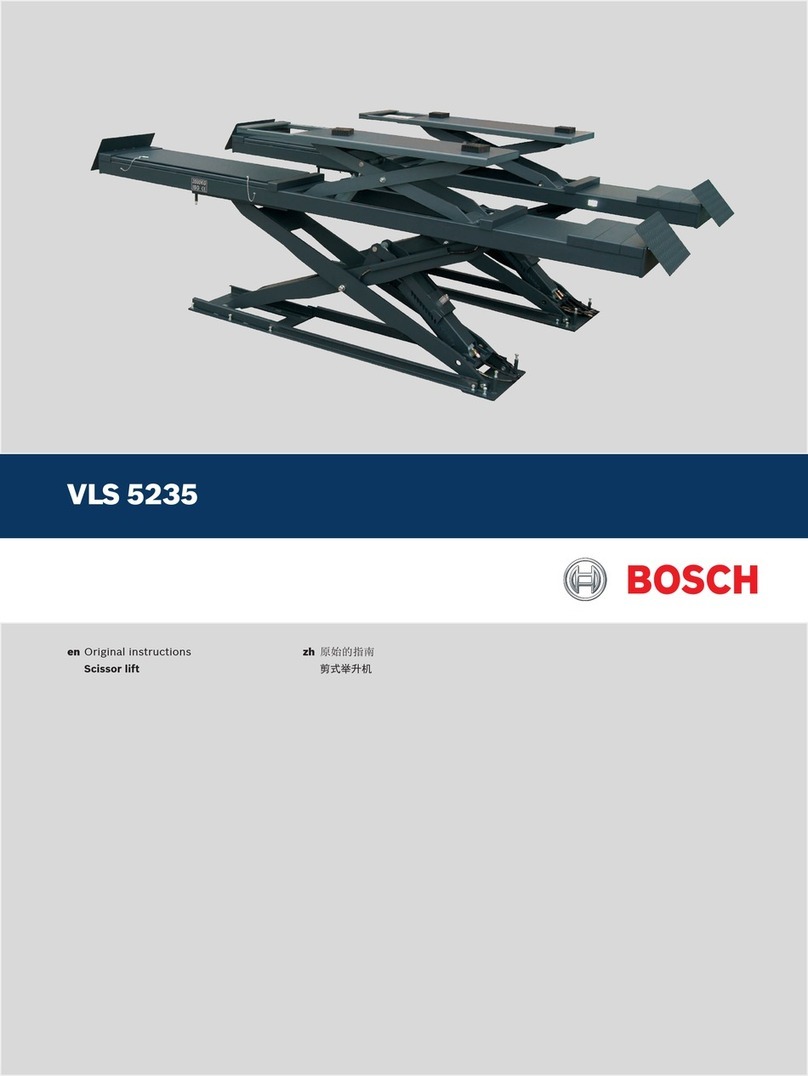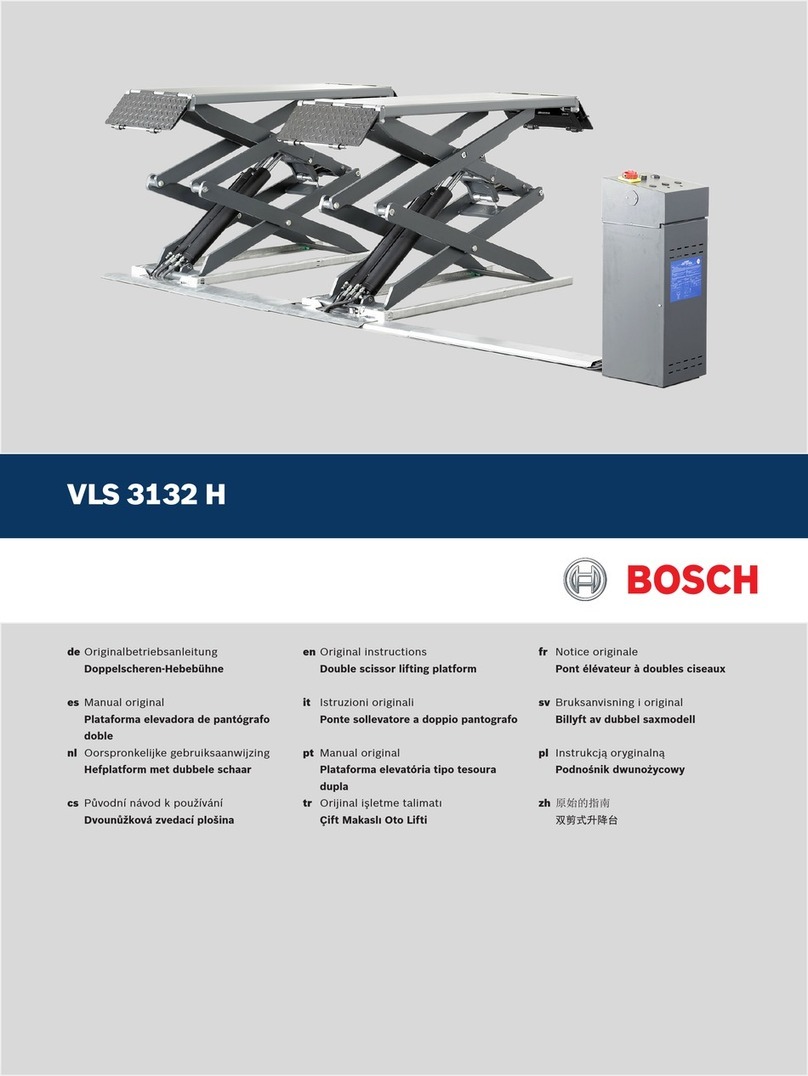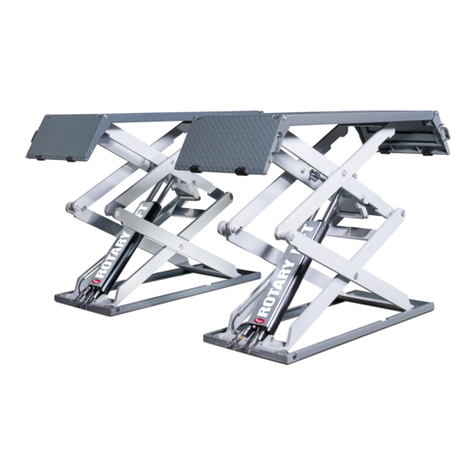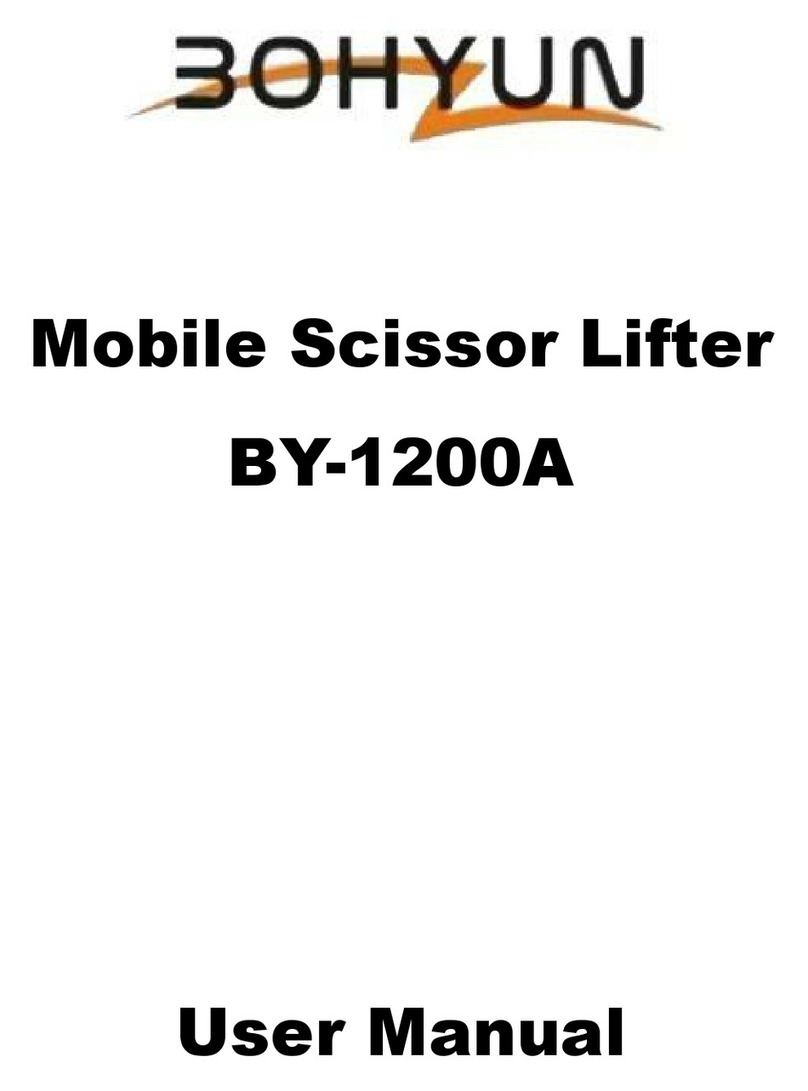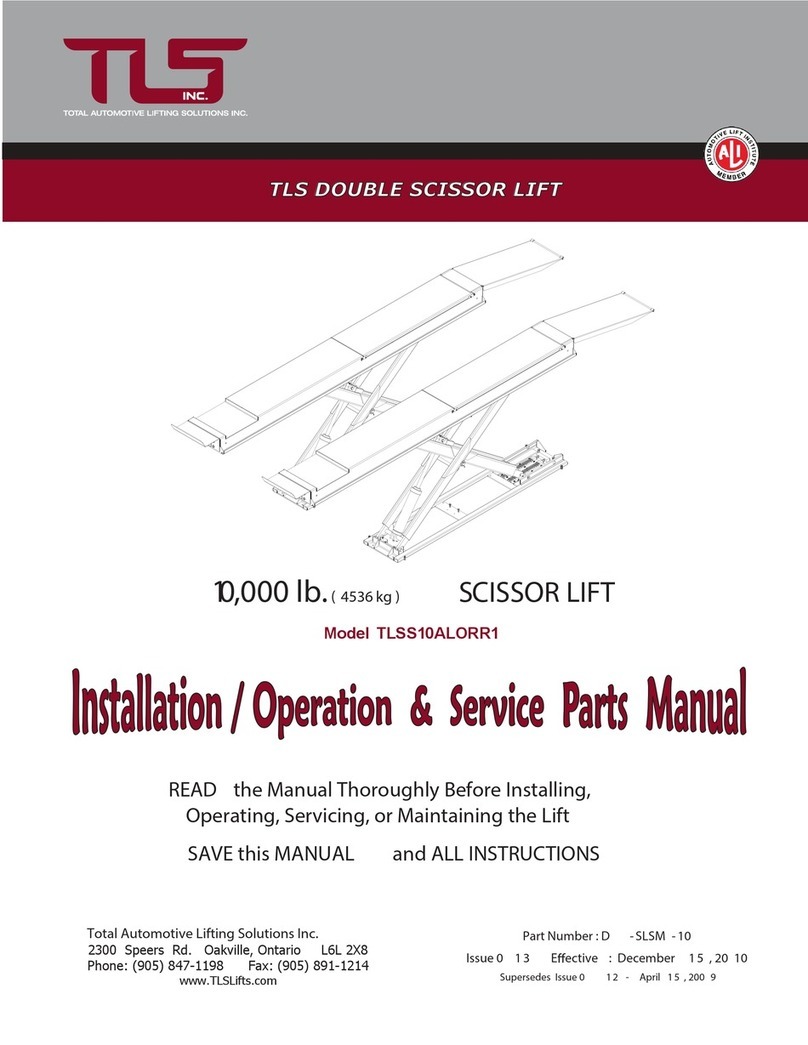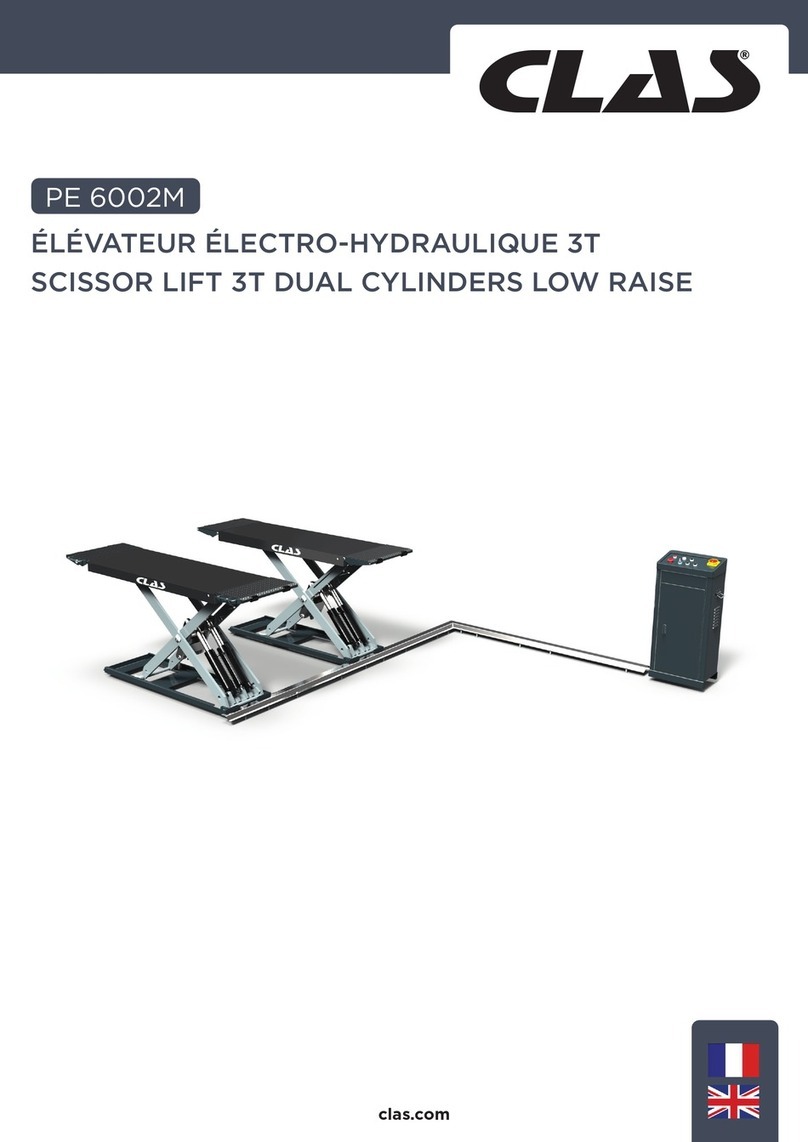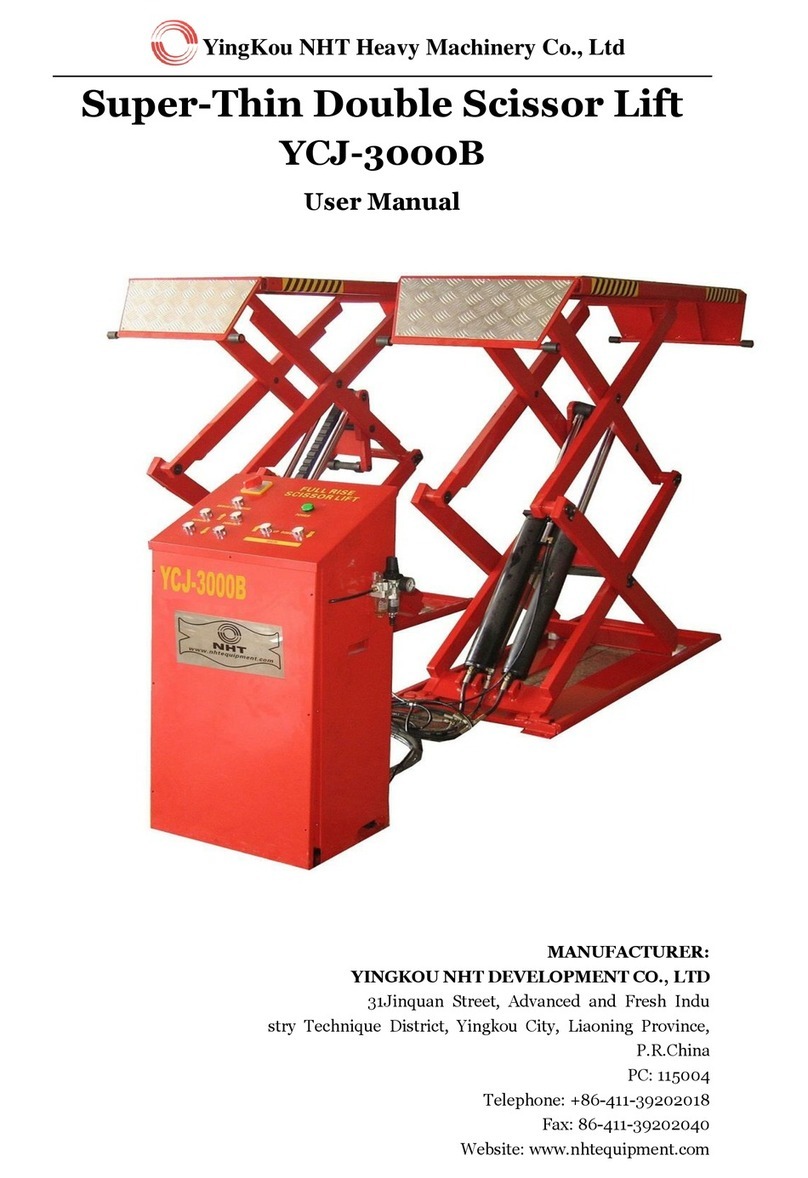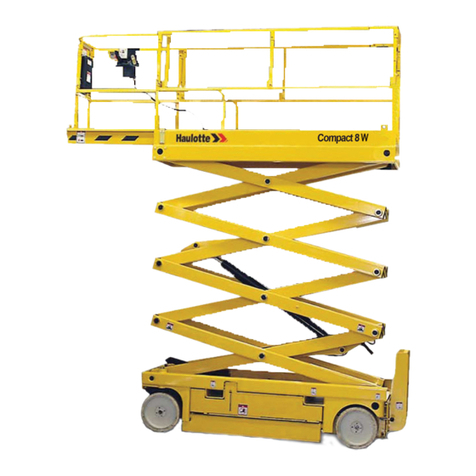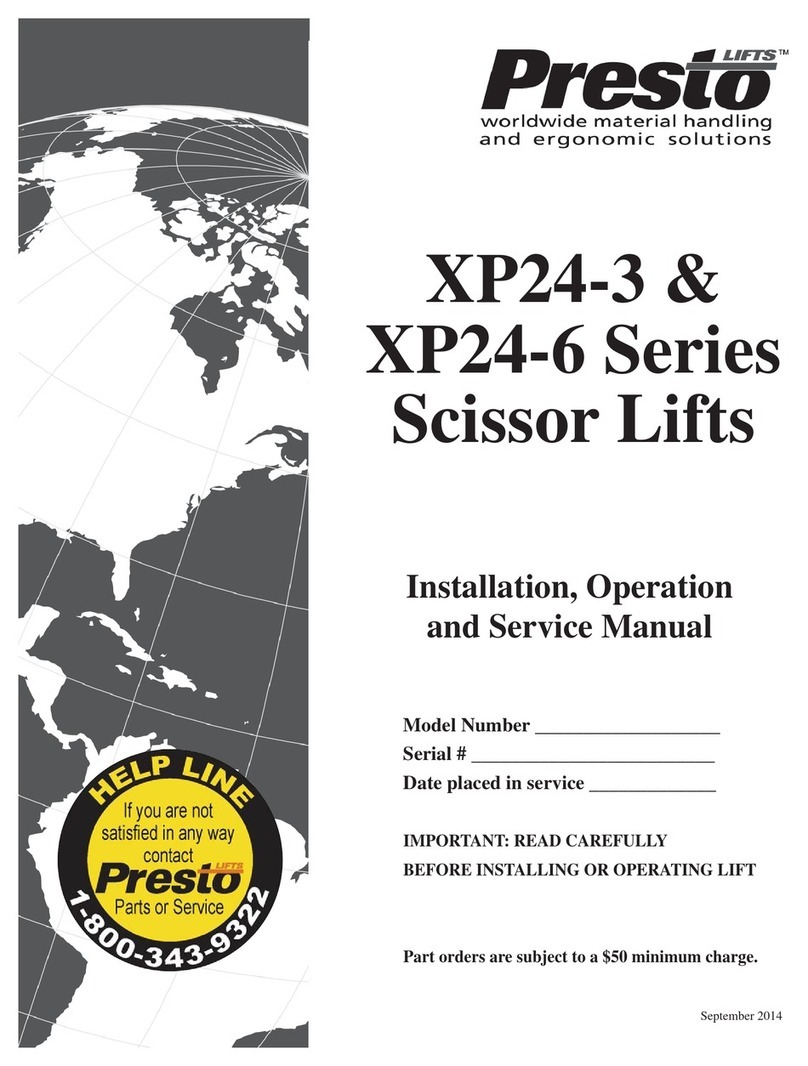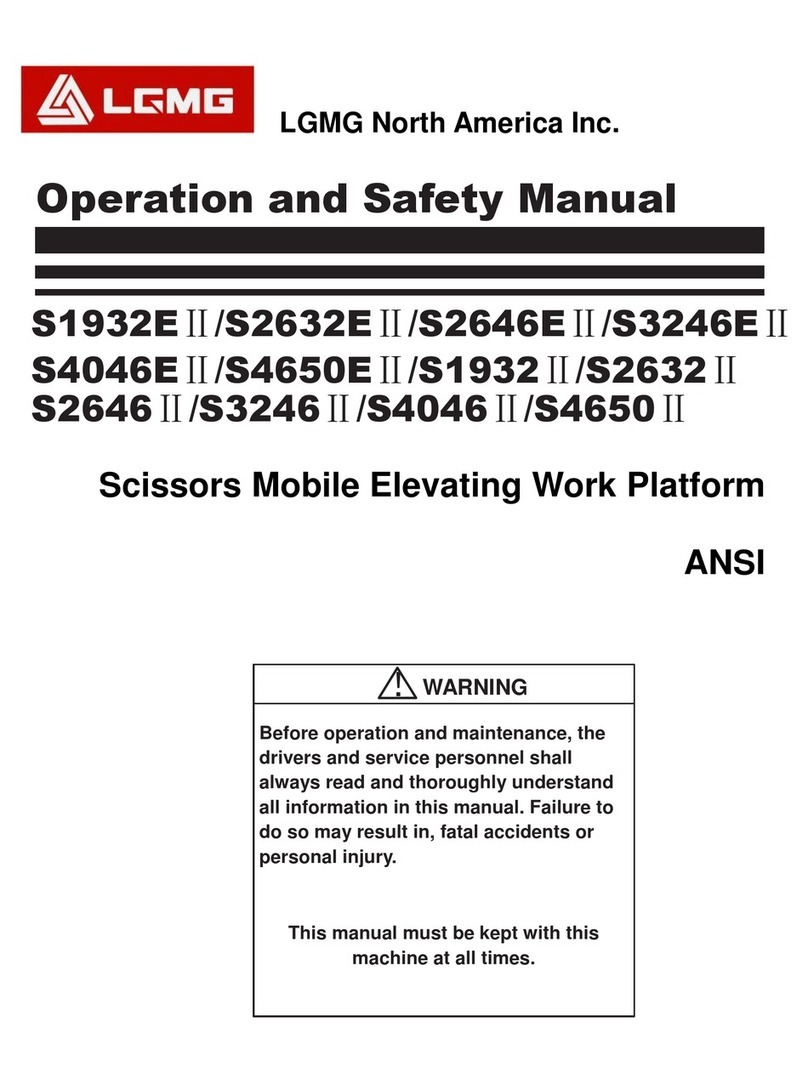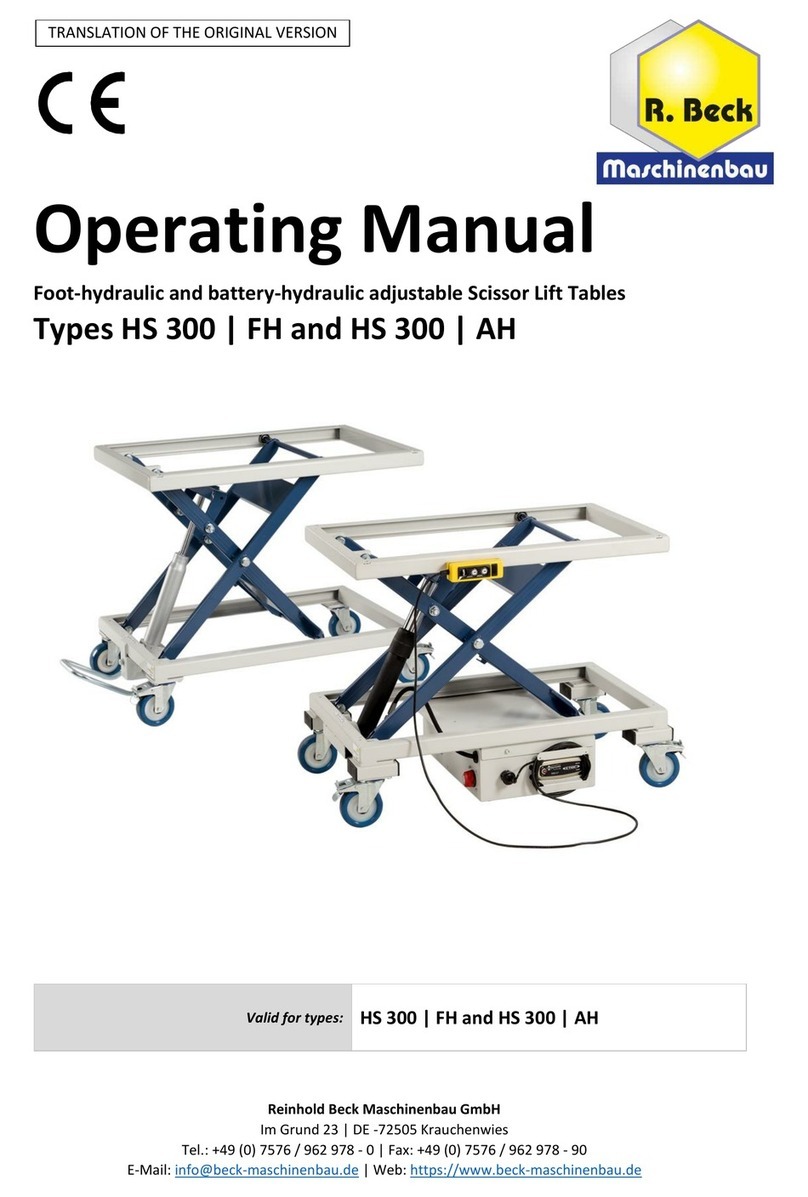Bosch JLR-100-069 User manual

JLR-100-069
Scissors Lift Table
en-gb Original Instructions
bg Оригинално ръководство за
експлоатация
cs Originální návod k použití
da Originale brugsanvisninger
de Originalbetriebsanleitung
el Πρωτότυπο οδηγιών χρήσης
es-es Instrucciones originales
et Originaalkasutusjuhend
fi Alkuperäiset ohjeet
fr-fr Instructions d'origine
hr Izvorne upute
hu Eredeti útmutató
it Istruzioni originali
ja 元の手順
ko 원래 지침
lt Originali instrukcija
lv Instrukcijas oriģinālvalodā
nl Originele instructies
pl Oryginalne instrukcje
pt-pt Instruções originais
ro Instrucţiuni originale
ru Инструкции на языке оригинала
sk Pôvodný návod
sl Originalna navodila za uporabo
sv Originalinstruktioner
tr Orijinal Talimatlar
zh-cn 原始说明


Table of Contents – English (Great Britain)
1 General Information ....................................................................................................... 7
2 Safety ............................................................................................................................ 10
2.1 General Safety Instructions ...................................................................................................................... 10
2.2 Description of the Safety Information on the Scissors Lift Table ........................................................... 11
2.3 Safety Equipment ...................................................................................................................................... 11
2.3.1 Protective Bellows ................................................................................................................................. 11
2.3.2 Foot Protection ...................................................................................................................................... 12
2.3.3 Hydraulic Pressure Relief Valve ............................................................................................................. 12
2.3.4 Mechanical Lock ..................................................................................................................................... 13
2.3.5 Ball Valve and Padlock ........................................................................................................................... 14
3 Setting up the Scissors Lift Table ................................................................................ 15
3.1 Removing the Packaging ........................................................................................................................... 15
3.2 Attaching the Handle to the Scissors Lift Table ....................................................................................... 16
3.3 Assembling the Lever ................................................................................................................................ 16
3.4 Preparing the Pump Assembly .................................................................................................................. 17
3.5 Removing the Scissors Lift Table from the Pallet .................................................................................... 17
3.6 Connecting the Compressed-Air Supply ................................................................................................... 18
3.7 Removing the Packaging Protection ......................................................................................................... 18
3.8 Inspecting the Functionality of the Hydraulic System and Scissors Component ................................... 19
3.9 Inspecting the Tilting Functionality of the Platforms .............................................................................. 19
3.10 Inspecting the Extension Functionality of the Platforms ...................................................................... 19
4 Operating Instructions ................................................................................................. 20
5 Inspection and Maintenance ........................................................................................ 27
5.1 General Maintenance Work ...................................................................................................................... 28
5.1.1 Protective Bellows ................................................................................................................................. 28
5.1.2 Hydraulic Oil ........................................................................................................................................... 29
5.1.3 Compressed-Air Supply .......................................................................................................................... 29
5.2 Inspecting the Scissors Lift Table for Visible Damage ............................................................................. 30
5.3 Inspecting the Connections between the Pump and Hydraulic Cylinders .............................................. 30
5.4 Inspecting the Functionality of the Mechanical Lock .............................................................................. 31
en-gb | 5 | JLR-100-069
SP04006297 | 06/2021 Bosch Automotive Service Solutions GmbH
Am Dörrenhof 1
85131 Pollenfeld-Preith
Germany

5.5 Cleaning the Protective Bellows ............................................................................................................... 31
5.6 Cleaning the Scissors Lift Table ............................................................................................................... 31
5.7 Inspecting the Hose for Leaks .................................................................................................................. 31
5.8 Lubricating the Joints ............................................................................................................................... 31
5.9 Inspecting the Hydraulic Cylinders for Leaks .......................................................................................... 32
5.10 Inspecting the Functionality of the Pump .............................................................................................. 33
5.11 Draining, Flushing, and Refilling the Pump Reservoir ........................................................................... 33
6 Replacement Parts ....................................................................................................... 34
6.1 Handle ........................................................................................................................................................ 35
6.2 Grip ............................................................................................................................................................ 35
6.3 Brake Covers ............................................................................................................................................. 36
6.4 Compressed-Air Hose Clamp .................................................................................................................... 36
6.5 Rubber Corners ......................................................................................................................................... 37
6.6 End Discs, Black ........................................................................................................................................ 36
6.7 Castor Wheels with Foot Protection ........................................................................................................ 38
6.8 Locking Pin ................................................................................................................................................ 39
6.9 Rubber Mats and Bushings ....................................................................................................................... 42
6.10 Protective Bellows .................................................................................................................................. 43
6.11 Spring ....................................................................................................................................................... 44
6.12 Lever to Release the Mechanical Lock ................................................................................................... 47
6.13 Spindles ................................................................................................................................................... 48
7 Disposal ........................................................................................................................ 53
7.1 Hydraulic Oil .............................................................................................................................................. 53
7.2 Scrap Metal ................................................................................................................................................ 53
Declaration of Conformity ............................................................................................... 54
Declaration of Conformity UKCA ..................................................................................... 55
en-gb | 6 | JLR-100-069
SP04006297 | 06/2021 Bosch Automotive Service Solutions GmbH
Am Dörrenhof 1
85131 Pollenfeld-Preith
Germany

1 General Information
Specifications for Scissors Lift Table
Product Name: Scissors Lift Table
Product Type: Lifting Equipment
Product Number: JLR-100-069
Weight: 628 kg
Maximum Load
Capacity: 1400 kg
Maximum Pneumatic
Input Pressure: 6 bar (87.02 psi)
Maximum Hydraulic
Pressure: 450 bar
Lift Category: 2
Noise Emission: 86 dB(A)
Width: 977 mm
Length: 2295 mm
Height, Completely
Collapsed: 580 mm
Height, Completely
Raised: 1835 mm
Static Test Coefficient: 1.5
Specifications for Platforms
Weight, Static Platform: 55.783 kg
Weight, Extendible
Platform: 55.645 kg
Maximum Load
Capacity, Extended
Platform:
800 kg
Surface Width: 800 mm
Length, Platforms
Completely Pushed in: 1806 mm
Length, Platforms
Completely Extended: 2136 mm
Threaded Holes in
Platforms, Size: M10
Threaded Holes in
Platforms, Max.
Torque::
47 Nm
Intended Use:
To lift, lower, and transport loads, such as a high-
voltage/BEV/PHEV battery, engine, transmission,
seat, fuel tank, or axle.
Terms of Use:
To be used only by qualified personnel trained in
accordance with the automobile manufacturer's
standards.
Use only for work expressly approved by the
automobile manufacturer.
Use only on level, even, and stable ground.
Use only indoors.
Do not use in corrosive environments (e.g. acidic
or caustic).
Do not use in potentially explosive environments.
Use only at ambient air temperatures between
10 °C and 45 °C.
Use only at a relative humidity between 32 % and
86 %.
Use only at a pneumatic input pressure up to 6 bar
(87.02 psi).
Use for loads only up to 1400 kg. When extending
the platforms, ensure that the load on the
extendible platform does not exceed 800 kg.
Do not use to lift persons or animals.
Use the lifting equipment only with the accessories
that have been expressly approved by the
automobile manufacturer.
en-gb | 7 | JLR-100-069
SP04006297 | 06/2021 Bosch Automotive Service Solutions GmbH
Am Dörrenhof 1
85131 Pollenfeld-Preith
Germany

Included in Delivery:
Product Number: Product Name: Quantity:
SP04003478 Handle 1
SP04003780 Grip 1
SP04004182 Brake Covers with M5 Screws 2
SP04004458 Compressed-Air Hose Clamp 1
SP04004462 Rubber Corners 4
SP04004876 End Discs, Black 2
SP04004968 Castor Wheels with Foot Protection 4
SP04005109 Locking Pin 1
SP04005970 Protective Bellows 1
SP04006259 Spring 1
SP04006343 Lever to Release the Mechanical Lock 1
SP04006416 Spindles 2
Optional Accessories:
Product Number: Product Name: Quantity:
SP04005327 Bushings 10
SP04005707 Rubber Mat for Platform (Static) 1
SP04005708 Rubber Mat for Platform (Extendible) 1
en-gb | 8 | JLR-100-069
SP04006297 | 06/2021 Bosch Automotive Service Solutions GmbH
Am Dörrenhof 1
85131 Pollenfeld-Preith
Germany

Figure 1: Scissors Lift Table JLR-100-069
1Handle
2Lever to Release the Mechanical Lock
3Platform (static)
4Platform (extendible)
5Protective Bellows
6Castor Wheels (4 pieces)
7Bottom Frame
8Compressed-Air Hose Clamp
9Pedal (end marked "RELEASE")
10 Pump
11 Pedal (end marked "PUMP")
12 Brake Pedal
en-gb | 9 | JLR-100-069
SP04006297 | 06/2021 Bosch Automotive Service Solutions GmbH
Am Dörrenhof 1
85131 Pollenfeld-Preith
Germany

2 Safety
2.1 General Safety Instructions
WARNING
Read and follow all safety notes and instructions!
Failure to follow the safety instructions could result in
serious injuries and severe damage to materials.
Observe and follow the safety notes below.
The lifting equipment has been specifically
constructed for its intended use. The safety of the
lifting equipment can no longer be ensured if it is
misused or modified in ways not expressly
approved by the manufacturer. Serious personal
injuries or severe damage to materials could occur.
Ensure that each person using the lifting
equipment is familiar with these instructions and
can access them at all times.
Ensure that all users are also familiar with the
instructions for additional special tools and
equipment that are required for the repair work.
Read and follow the automobile manufacturer's
workshop manual carefully.
Use the lifting equipment only for work that has
been expressly approved by the automobile
manufacturer.
Do not climb on the lifting equipment.
Do not use the lifting equipment to lift persons or
animals.
Use the lifting equipment only to support and lift
vehicle parts, never an entire vehicle.
Wear safety shoes that meet the ISO 20345, S2
standard.
Wear safety gloves that meet the EN 388 standard.
Position hands and feet so as to avoid potential
crushing hazards.
Do not exceed the maximum load capacities
specified in these instructions, neither for the
entire scissors lift table, nor for the extended
platform.
To be used only by persons in good physical
condition.
Use only with the help of an assistant.
Ensure that the load centre is in the middle of the
scissors lift table.
Ensure that the load remains stable and will not tip
on the scissors lift table.
Ensure that the path remains clear and easily visible.
Move the scissors lift table with loads on it only
when the platforms are in the lowest possible
position.
Move the scissors lift table on ground that is as
even as possible. Do not move the scissors lift
table over slopes above 3.5°, with the exception of
the ramp included in delivery.
Move the scissors lift table on ground that is as
even as possible. Do not move the scissors lift
table over slopes above 2° when loads are on it.
Do not move the scissors lift table at a speed
faster than 4 km/h.
Do not work underneath loads.
Perform work only at an ergonomic height.
Use the scissors lift table only with the protective
bellows in place.
Put loads on the platforms at angles of only up to
2°.
Ensure that the filler plug is unscrewed slightly to
raise and lower the platforms. Re-tighten the filler
plug to transport the scissors lift table over longer
distances.
Place the forklift forks to lift the scissors lift table
only between the forklift signs on the bottom frame.
en-gb | 10 | JLR-100-069
SP04006297 | 06/2021 Bosch Automotive Service Solutions GmbH
Am Dörrenhof 1
85131 Pollenfeld-Preith
Germany

2.2 Description of the Safety
Information on the Scissors Lift
Table
Icon Description
Risk of injuries to hands
Do not place hands or feet here
Do not climb on the platforms
Do not place forklift forks to the left of
this sign
Do not place forklift forks to the right of
this sign
Maximum load capacity, total (1400 kg)
Maximum load capacity for the extendible
platform (800 kg)
Maximum load capacity for the extendible
platform (800 kg)
Maximum Pneumatic Input Pressure
(6 bar, 87.02 psi)
2.3 Safety Equipment
Danger Safety
Equipment Section
Crushing Hazard for
Hands or Fingers Protective
Bellows 2.3.1
Crushing Hazard for
Feet Foot Protection 2.3.2
Falling or Jammed
Platforms Hydraulic
Pressure Relief
Valve
2.3.3
Platforms Falling
Uncontrollably Hydraulic Fail-
Safe 2.3.4
Platforms Falling
Uncontrollably Mechanical Lock 2.3.4
Use by Unauthorised
Individuals Ball Valve with
Padlock 2.3.5
2.3.1 Protective Bellows
Figure 2: Protective Bellows (5)
Use the scissors lift table only with the protective
bellows (5) in place.
CAUTION
Crushing Hazard in the Scissors Element!
Hands or fingers could be crushed when raising or
lowering the platforms.
Open the protective bellows only when there are
no loads on the platforms.
Open the protective bellows only for the
maintenance work specified in these instructions.
Use the scissors lift table only with the protective
bellows in place.
Only qualified personnel may open the protective
bellows.
Keep hands and feet out of the scissors element.
Close the protective bellows after the maintenance
work has been completed.
en-gb | 11 | JLR-100-069
SP04006297 | 06/2021 Bosch Automotive Service Solutions GmbH
Am Dörrenhof 1
85131 Pollenfeld-Preith
Germany

2.3.2 Foot Protection
Figure 3: Castor Wheel, Detailed View
6Castor Wheel
13 Directional Lock
14 Foot Protection
Ensure that the foot protection (14) is in place on all
the castor wheels (6).
CAUTION
Crushing Hazards to Feet!
The scissors lift table could roll over the users' feet if
the foot protection is not in place.
Never remove the foot protection from any of the
castor wheels.
2.3.3 Hydraulic Pressure Relief Valve
Figure 4: Hydraulic Pressure Relief Valve, Detailed View
15 Hydraulic Pressure Relief Valve
16 Compressed-Air Connection
The hydraulic pressure relief valve (15) ensures that
the platforms (3) and (4) are always raised and
lowered evenly and in the same way. Never adjust the
hydraulic pressure relief valve (15).
CAUTION
Danger of the platforms falling or being blocked!
The platforms could be lowered too fast or not move
at all if the hydraulic pressure relief valve is not
adjusted correctly.
Never adjust the hydraulic pressure relief valve.
Only the manufacturer may adjust the hydraulic
pressure relief valve.
en-gb | 12 | JLR-100-069
SP04006297 | 06/2021 Bosch Automotive Service Solutions GmbH
Am Dörrenhof 1
85131 Pollenfeld-Preith
Germany

2.3.4 Mechanical Lock
Figure 5: Scissors Element
1Handle
17 Mechanical Lock
18 Locking Block
There is a mechanical lock (17) and a hydraulic fail-
safe on the scissors lift table. Both pieces of safety
equipment prevent the platforms (3) and (4) from
falling uncontrollably.
If the locking block (18) collides against the
mechanical lock (17), the mechanical lock (17) will
prevent the platforms (3) and (4) from falling further.
Perform the following steps to release the platforms
(3) and (4).
WARNING
Risk of Personal Injuries!
If the platforms are not released after the lever has
been pressed, the scissors lift table is severely
damaged and can cause serious personal injuries or
severe damage to materials.
Take the scissors lift table out of operation
immediately and call the service hotline.
1. Insert the compressed-air hose through the
compressed-air hose clamp (8).
Figure 6: Attaching the Compressed-Air Hose to the
Scissors Lift Table
1Handle
8Compressed-Air Hose Clamp
9Pedal (end marked "RELEASE")
10 Pump
11 Pedal (end marked "PUMP")
12 Brake Pedal
en-gb | 13 | JLR-100-069
SP04006297 | 06/2021 Bosch Automotive Service Solutions GmbH
Am Dörrenhof 1
85131 Pollenfeld-Preith
Germany

2. Connect the compressed-air supply to the
scissors lift table.
The compressed-air connection has a 1/4 inch
external thread.
Use clean and dry compressed air with a
pneumatic input pressure only up to 6 bar
(87.02 psi).
Figure 7: Connecting the Compressed-Air Supply
7Bottom Frame
9Pedal (end marked "RELEASE")
10 Pump
11 Pedal (end marked "PUMP")
12 Brake Pedal
15 Hydraulic Pressure Relief Valve
16 Compressed-Air Connection
19 Ball Valve
20 Manometer Connection
3. If necessary, unlock the padlock on the ball valve
(19). Twist the ball valve (19) until it is parallel to
the bottom frame (7) to release the platforms (3)
and (4).
4. Press the end of the pedal marked "PUMP" (11)
to raise the platforms (3) and (4).
The pedal may briefly vibrate when pressed. This
is normal and presents no danger.
5. Press the lever (2) to release the mechanical lock
(17). Simultaneously press the end of the pedal
marked "RELEASE" (9) to lower the platforms (3)
and (4).
2.3.5 Ball Valve and Padlock
The lockable ball valve (19) with the padlock protects
the scissors lift table from being used by unauthorised
persons.
en-gb | 14 | JLR-100-069
SP04006297 | 06/2021 Bosch Automotive Service Solutions GmbH
Am Dörrenhof 1
85131 Pollenfeld-Preith
Germany

3 Setting up the Scissors Lift
Table
NOTICE
Danger of Destroying the Pump!
If the platforms are raised before the pump has been
prepared, the pump could be destroyed.
Set up the scissors lift table only in the order
specified in this chapter.
The packaging also serves to remove the scissors lift
table from the pallet.
Dispose of packaging that is no longer needed in a
suitable location and in accordance with all
applicable regulations.
Figure 8: Scissors Lift Table on the Pallet
1Handle
10 Pump
21 Cover/Ramp
22 Pallet
23 Wooden Pegs (4 pieces)
24 Wooden Strips (2 pieces)
3.1 Removing the Packaging
1. Cut the straps on the carton with a knife, cutting
pliers, or scissors. Remove the straps from the
carton. Remove the carton from the pallet (22).
2. Cut the cable ties on the handle (1) with a knife,
cutting pliers, or scissors. Remove the cable ties
from the handle (1). Remove the handle (1) from
the pallet (22).
3. Remove the two spax screws from the cover (21).
Remove the cover (21) from the scissors lift
table. Position the pallet (22) so that the cover
(21) creates a ramp to the ground [on the side of
the pump (10)].
Figure 9: Attaching the Ramp to the Pallet
10 Pump
21 Cover/Ramp
22 Pallet
en-gb | 15 | JLR-100-069
SP04006297 | 06/2021 Bosch Automotive Service Solutions GmbH
Am Dörrenhof 1
85131 Pollenfeld-Preith
Germany

4. Prevent the scissors lift table from rolling by
pressing the brake pedal (12) to activate the
brakes.
WARNING
Rolling Scissors Lift Table!
If the scissors lift table is moved unintentionally,
it could bump or roll into something, which could
cause serious personal injuries or severe
damages to materials.
Always activate the brakes after moving the
scissors lift table.
Do not use the brake pedal to decelerate the
scissors lift table while it is moving.
Figure 10: Activating the Brakes
9Pedal (end marked "RELEASE")
10 Pump
11 Pedal (end marked "PUMP")
12 Brake Pedal
3.2 Attaching the Handle to the
Scissors Lift Table
1. Push the handle (1) into the bottom frame (7) so
that the holes in the frame (7) align with the
holes in the handle (1).
Figure 11: Attaching the Handle to the Scissors Lift Table
1Handle
7Bottom Frame
8Compressed-Air Hose Clamp
25 Hexagon Head Screws M8 x 45 8.8 (4 pieces)
2. Tighten all four hexagon head screws (25) in the
holes with a torque of 25 Nm.
3.3 Assembling the Lever
Figure 12: Handle, Detailed View
1Handle
2Lever to Release the Mechanical Lock
Place the lever (2) on the handle (1). The magnet will
hold the lever (2) on the handle (1).
en-gb | 16 | JLR-100-069
SP04006297 | 06/2021 Bosch Automotive Service Solutions GmbH
Am Dörrenhof 1
85131 Pollenfeld-Preith
Germany

3.4 Preparing the Pump Assembly
Figure 13: Pump, Detailed View
9Pedal (end marked "RELEASE")
10 Pump
11 Pedal (end marked "PUMP")
26 Filler Plug
1. Clean the entire area around the filler plug (26).
2. Unscrew the filler plug (26) on the pump (10) by
half a rotation counter-clockwise.
NOTICE
Danger of Destroying the Pump!
The filler plug is tight on the pump when the
scissors lift table is delivered. The pump could be
destroyed if the platforms are raised or lowered
when the filler plug is still tight.
Tighten the filler plug clockwise only to
transport the scissors lift table over longer
distances to prevent leaks.
Always ensure that the filler plug is unscrewed
by half a rotation counter-clockwise when
raising and lowering the platforms.
3.5 Removing the Scissors Lift Table
from the Pallet
1. Remove the wooden strips (24) from in front of
the castor wheels (6) (see Figure 8).
2. Push up the brake pedal (12) to release the brakes.
3. Hold the handle (1). Slowly roll the scissors lift
table down the ramp (21) with the help of an
assistant.
WARNING
Danger of the Scissors Lift Table Rolling on
Slopes and Ramps!
The scissors lift table could roll down slopes and
ramps by itself. The scissors lift table is heavy
and therefore has a longer braking distance.
Handling the scissors lift table on slopes and
ramps carelessly could cause serious personal
injuries or severe damage to materials.
Move the scissors lift table on ground that is
as even as possible. Do not move the scissors
lift table over slopes above 3.5°, with the
exception of the ramp included in delivery.
Move the scissors lift table in the direction of
the slope, not across it.
Personnel must remain above the scissors lift
table on slopes.
Use the scissors lift table only with the help of
an assistant to control its movements.
4. Prevent the scissors lift table from rolling by
pressing the brake pedal (12) to activate the
brakes.
en-gb | 17 | JLR-100-069
SP04006297 | 06/2021 Bosch Automotive Service Solutions GmbH
Am Dörrenhof 1
85131 Pollenfeld-Preith
Germany

3.6 Connecting the Compressed-Air
Supply
1. Insert the compressed-air hose through the
compressed-air hose clamp (8).
Figure 14: Attaching the Compressed-Air Hose to the
Scissors Lift Table
1Handle
8Compressed-Air Hose Clamp
9Pedal (end marked "RELEASE")
10 Pump
11 Pedal (end marked "PUMP")
12 Brake Pedal
2. Connect the compressed-air supply to the
scissors lift table.
The compressed-air connection has a 1/4 inch
external thread.
Use clean and dry compressed air with a
pneumatic input pressure only up to 6 bar
(87.02 psi).
Figure 15: Connecting the Compressed-Air Supply
7Bottom Frame
9Pedal (end marked "RELEASE")
10 Pump
11 Pedal (end marked "PUMP")
12 Brake Pedal
15 Hydraulic Pressure Relief Valve
16 Compressed-Air Connection
19 Ball Valve
20 Manometer Connection
3. If necessary, unlock the padlock on the ball valve
(19). Twist the ball valve (19) until it is parallel to
the bottom frame (7) to release the platforms (3)
and (4).
3.7 Removing the Packaging Protection
1. Press the end of the pedal marked "PUMP" (11)
to raise the platforms (3) and (4) slightly.
The pedal may briefly vibrate when pressed. This
is normal and presents no danger.
2. Remove the wooden pegs (23) from the scissors
lift table (see Figure 8).
en-gb | 18 | JLR-100-069
SP04006297 | 06/2021 Bosch Automotive Service Solutions GmbH
Am Dörrenhof 1
85131 Pollenfeld-Preith
Germany

3.8 Inspecting the Functionality of the
Hydraulic System and Scissors
Component
Completely raise and lower the platforms (3) and (4)
without any loads on the scissors lift table once.
Press the end of the pedal marked "PUMP" (11) to
raise the platforms (3) and (4).
Press the lever (2) to release the mechanical lock
(17). Simultaneously press the end of the pedal
marked "RELEASE" (9) to lower the platforms (3) and
(4).
Ensure that the platforms (3) and (4) are only raised
or lowered when the pedal is pressed.
WARNING
Risk of Personal Injuries!
If the platforms continue to move after the pedal has
been released, the scissors lift table is severely
damaged and can cause serious personal injuries or
severe damage to materials.
Take the scissors lift table out of operation
immediately and call the service hotline.
3.9 Inspecting the Tilting Functionality
of the Platforms
Turn the spindles (27) to tilt the platforms (3) and (4)
in both directions completely.
There are several ways to turn the spindles (27):
Turn the spindles (27) with a 3/8 inch wrench.
Turn the spindles (27) with an open-end or
combination wrench, wrench size 21.
Turn the spindles (27) with a cordless screwdriver.
Figure 16: Tilting the Platforms
4Platform (extendible)
27 Spindles (2 pieces)
3.10 Inspecting the Extension
Functionality of the Platforms
Pull on and hold the locking pin (29). Use the grip
(28) to pull out and push in the extendible platform
(4). Ensure that the locking pin (29) locks into place
in all of its three positions.
Figure 17: Extending the Platform
4Platform (extendible)
28 Grip
29 Locking Pin
en-gb | 19 | JLR-100-069
SP04006297 | 06/2021 Bosch Automotive Service Solutions GmbH
Am Dörrenhof 1
85131 Pollenfeld-Preith
Germany

4 Operating Instructions
1. Ensure that the scissors lift table is complete and
inspect it for visible damage, such as bends,
cracks, dents, or damage to threaded holes in the
platforms. Do not use the scissors lift table if
damaged or in poor condition, but take it out of
operation immediately and call the service hotline.
2. Ensure that the ground is level, sturdy, and free
of obstruction.
WARNING
Danger of the Scissors Lift Table Rolling on
Slopes and Ramps!
The scissors lift table could roll down slopes and
ramps by itself. The scissors lift table is heavy
and therefore has a longer braking distance.
Handling the scissors lift table on slopes and
ramps carelessly could cause serious personal
injuries or severe damage to materials.
Move the scissors lift table on ground that is
as even as possible. Do not move the scissors
lift table over slopes above 3.5°, with the
exception of the ramp included in delivery.
Move the scissors lift table in the direction of
the slope, not across it.
Personnel must remain above the scissors lift
table on slopes.
Use the scissors lift table only with the help of
an assistant to control its movements.
3. If necessary, adjust the handle (1).
CAUTION
Danger of Personal Injuries when Moving the
Scissors Lift Table!
If the vehicle part protrudes beyond the edge of
the platforms, personal injuries could occur when
pushing or pulling the scissors lift table.
Adjust the handle so that the vehicle part does
not protrude beyond the handle and so that
there is enough room to use the handle to
move the scissors lift table.
Ensure that the path is clear and easily visible.
Remove the hexagon head screws (25) from the
handle (1) and set them aside.
Pull out or push in the handle (1) to the desired
position so that the holes in the bottom frame (7)
align with the holes in the handle (1).
Tighten all four hexagon head screws (25) in the
holes with a torque of 25 Nm.
Figure 18: Adjusting the Handle
1Handle
7Bottom Frame
25 Hexagon Head Screws M8 x 45 8.8 (4 pieces)
en-gb | 20 | JLR-100-069
SP04006297 | 06/2021 Bosch Automotive Service Solutions GmbH
Am Dörrenhof 1
85131 Pollenfeld-Preith
Germany

4. Push up the brake pedal (12) to release the brakes.
Figure 19: Activating the Brakes
9Pedal (end marked "RELEASE")
10 Pump
11 Pedal (end marked "PUMP")
12 Brake Pedal
5. For each pair of castor wheels (6), align both
directional locks (13) on the short side of the
bottom frame (7) in the same direction.
Fix the directional locks to manoeuvre the
scissors lift table more easily.
Figure 20: Castor Wheel, Detailed View
6Castor Wheel
13 Directional Lock
14 Foot Protection
6. Push the handle (1) to move the scissors lift table
to the work site or underneath the vehicle.
Move the scissors lift table only with the handle.
Never move the scissors lift table with the grip
on the extendible platform.
7. Prevent the scissors lift table from rolling by
pressing the brake pedal (12) to activate the
brakes.
WARNING
Rolling Scissors Lift Table!
If the scissors lift table is moved unintentionally,
it could bump or roll into something, which could
cause serious personal injuries or severe
damages to materials.
Always activate the brakes after moving the
scissors lift table.
Do not use the brake pedal to decelerate the
scissors lift table while it is moving.
en-gb | 21 | JLR-100-069
SP04006297 | 06/2021 Bosch Automotive Service Solutions GmbH
Am Dörrenhof 1
85131 Pollenfeld-Preith
Germany

8. Ensure that the platforms (3) and (4) are level on
the scissors lift table. If not, turn the spindles
(27) to tilt the platforms (3) and (4) until they are
level.
There are several ways to turn the spindles (27):
Turn the spindles (27) with a 3/8 inch wrench.
Turn the spindles (27) with an open-end or
combination wrench, wrench size 21.
Turn the spindles (27) with a cordless
screwdriver.
Figure 21: Straightening the Platforms
4Platform (extendible)
27 Spindles (2 pieces)
9. If necessary, place the rubber mats on the
platforms (3) and (4). Secure the rubber mats to
the platforms (3) and (4) with the bushings (30)
in the threaded holes (31) on top of the platforms
(3) and (4).
Figure 22: Platforms with Rubber Mats and Bushings
3Platform (static) with Rubber Mat
4Platform (extendible) with Rubber Mat
30 Bushings (10 pieces per set)
31 M10 Threaded Holes on Top of the Platforms
10. Insert the compressed-air hose through the
compressed-air hose clamp (8).
Figure 23: Attaching the Compressed-Air Hose to the
Scissors Lift Table
1Handle
8Compressed-Air Hose Clamp
9Pedal (end marked "RELEASE")
10 Pump
11 Pedal (end marked "PUMP")
12 Brake Pedal
en-gb | 22 | JLR-100-069
SP04006297 | 06/2021 Bosch Automotive Service Solutions GmbH
Am Dörrenhof 1
85131 Pollenfeld-Preith
Germany
Table of contents
Other Bosch Scissor Lift manuals
Popular Scissor Lift manuals by other brands
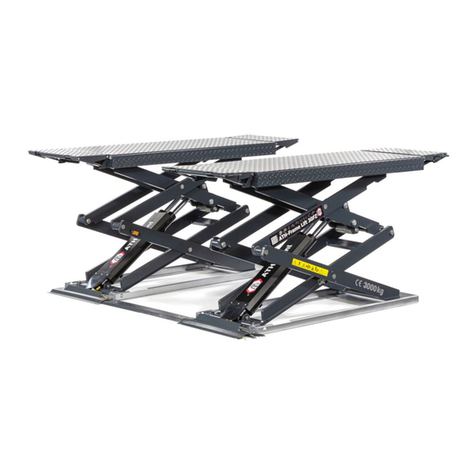
ATH
ATH Frame Lift 30FZ operating instructions
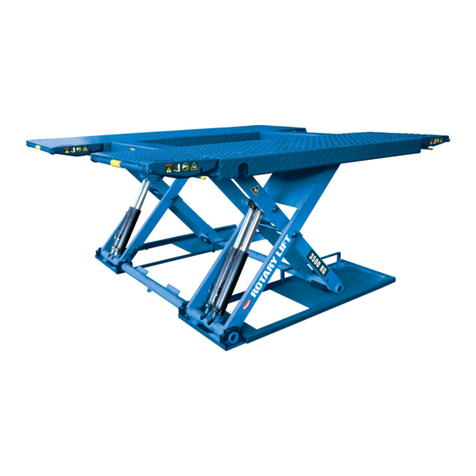
Rotary
Rotary 000 Series Operation & maintenance manual

Skyjack
Skyjack SJ519 TH operating manual

Youngman
Youngman BoSS X3X-SP Instructions for use
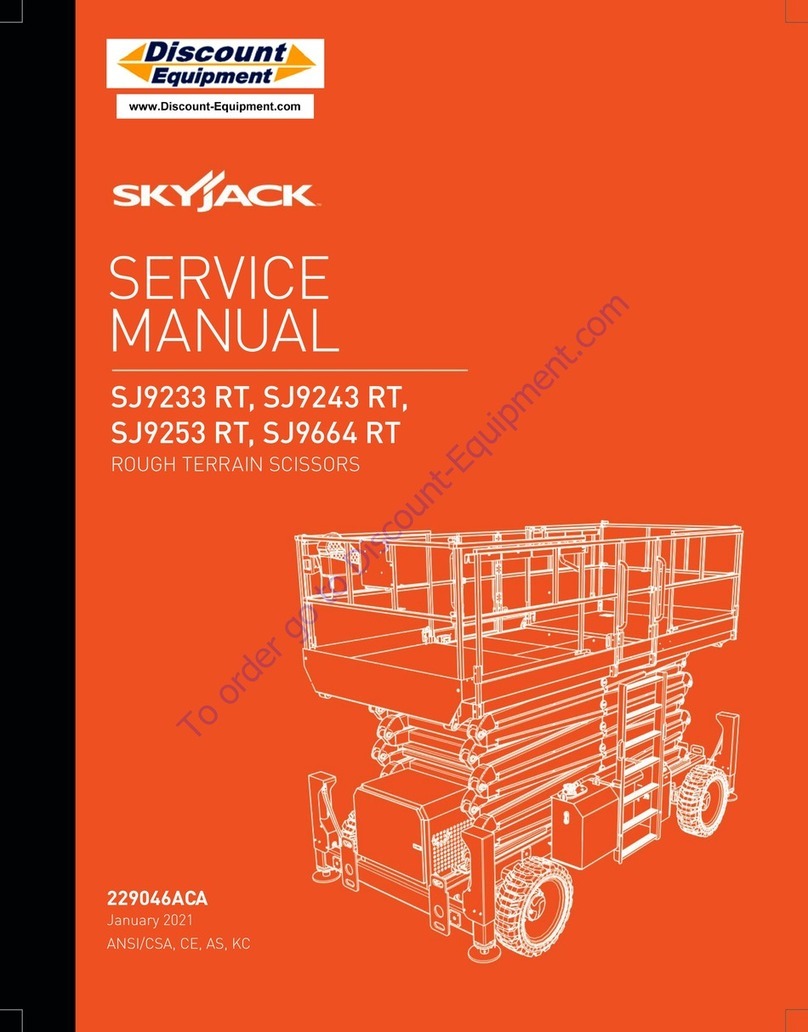
Skyjack
Skyjack SJ9233 RT Service manual
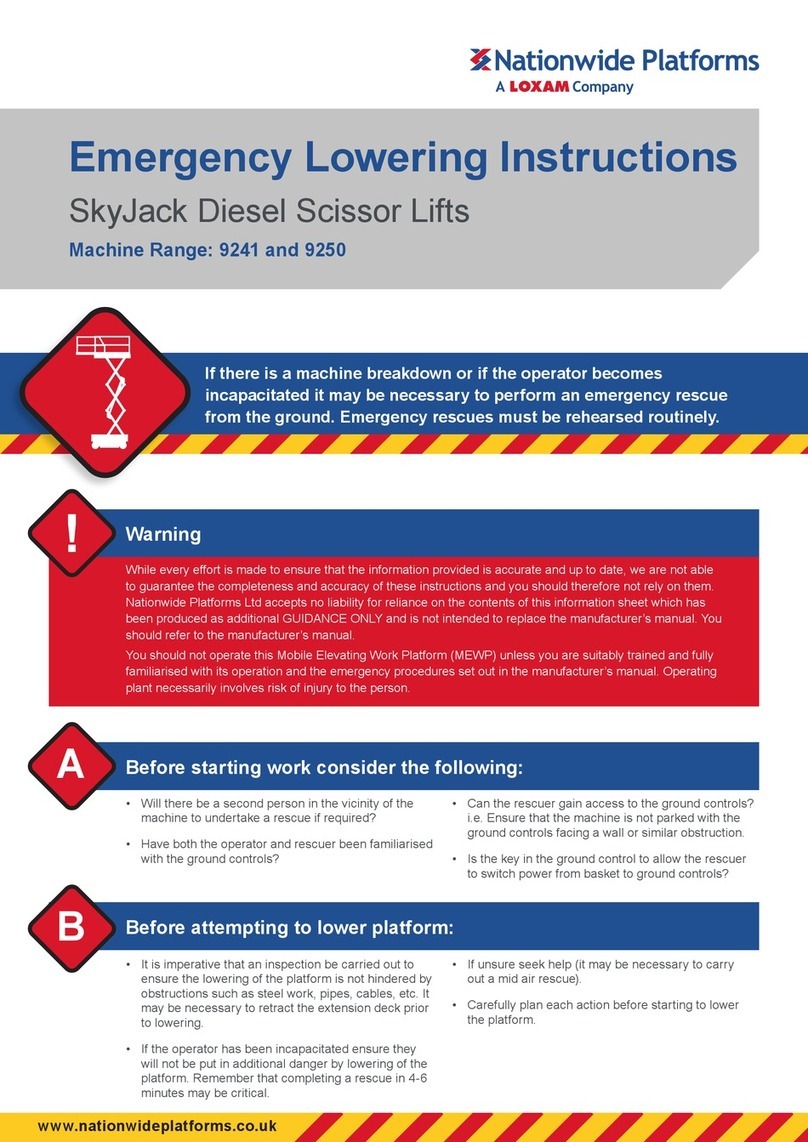
Loxam
Loxam Nationwide Platforms SkyJack 9241 Emergency Lowering Instructions
